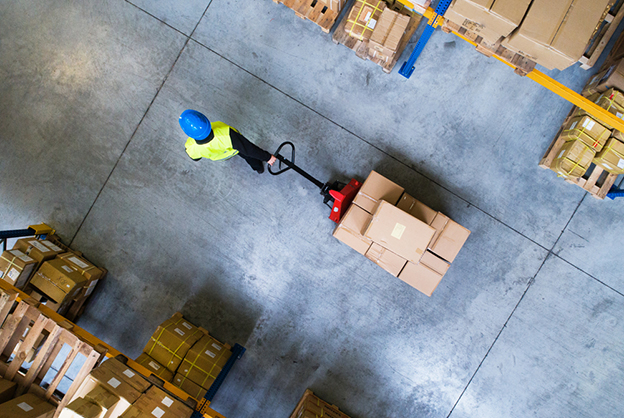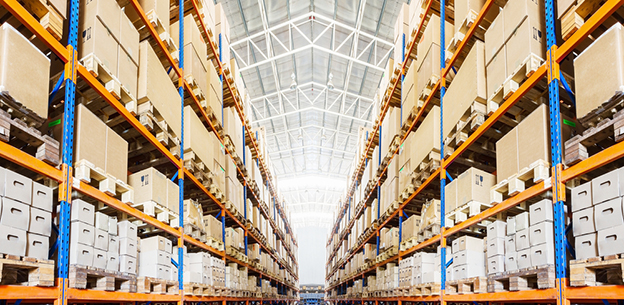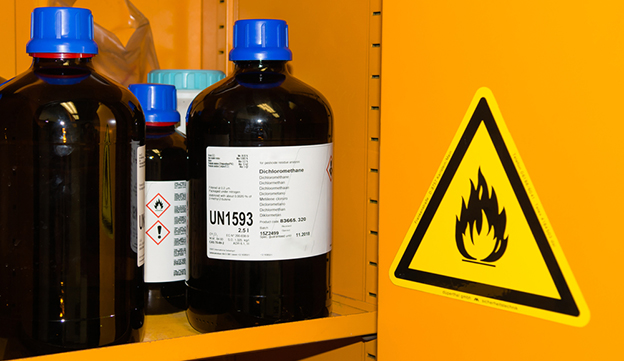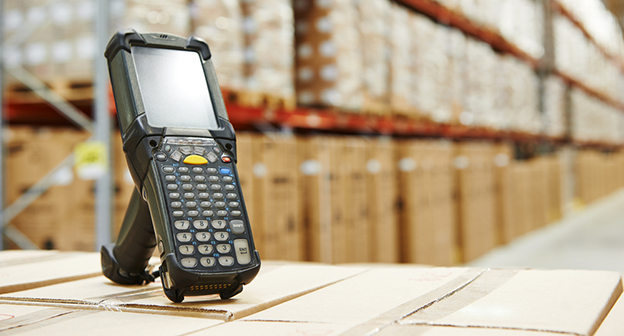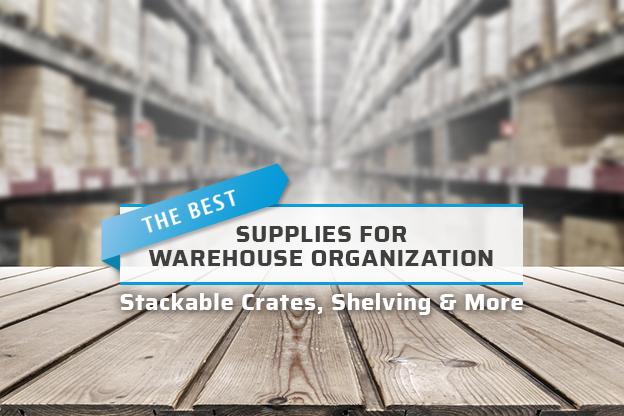
A warehouse can be a jungle of different products and equipment if you struggle to keep the space organized. When someone needs to find a product and get it ready for shipment, it may take them several minutes or more just to find all the materials they need.
This isn’t just an inconvenience; it’s a terrible habit that will slow down your business and lead to unnecessary costs. You’ll have to pay your employees as they root around the warehouse, your shipments won’t get out the door as fast as those of your competitors, and you’ll be paying for underutilized space. In fact, studies show that cluttered spaces actually make it more difficult to focus on a particular task.
But you can avoid this lag in productivity by keeping your warehouse space neat and organized — which doesn’t mean picking up after yourself but creating a vast system of shelves and storage containers with clearly labeled markers and tags that help your employees better navigate the space. Read on to learn about the best supplies for warehouse organization and how to put them to good use.
BEST SUPPLIES FOR KEEPING YOUR WAREHOUSE TIDY
Stackable Crates
Like a box of giant Legos, these interlocking stackable crates firmly sit on top of each other to help you make the most of your warehouse’s vertical space. You can build a tower and keep your crates off the ground while still accessing all the products and equipment stored inside.
Stackable crates make it easy to organize the space without a lot of startup costs. These crates are generally inexpensive and are mostly made of plastic, which won’t break your company’s budget. You can place them directly on the floor using a pallet without having to setup a shelving system, or you can use what’s called a stack rack to keep your crates off the floor. You can quickly arrange a series of aisles and columns with clear pathways for your employees and their equipment, including dollies and hand trucks.
One of the benefits of putting your crates on a pallet is that you don’t need to invest a lot of money in storage supplies, but you’ll have to move the top crates in order to reach those on the bottom, or just move the entire column together. However, if you use stack racks to keep your crates off the floor, you and your employees can easily move one crate at a time regardless of where they are in the stack.
If you’re looking to quickly get your warehouse space up and running, stackable crates are just what you’ve been looking for.
Wire Storage Baskets
Another effective storage solution, wire baskets help you keep up with the changing inventory of your warehouse. They’re extremely easy to use and fully collapsible, so you can tuck them away when they’re not in use. Just fold down the sides of the basket, and it becomes a flat container that can fit almost anywhere — so you won’t take up precious space when your baskets are empty. This helps you roll with your industry’s changes. Inventory can fluctuate on a dime, after all, so it’s best to invest in wire storage baskets so that you can quickly deploy them when you need some extra storage space.
These baskets are also see-through, so your employees will always know what’s inside. While every warehouse should have a coherent label system, wire storage baskets take the guesswork out of product retrieval. Your employees can visually scan their surroundings until they find what they need instead of having to read individual labels, which can be especially difficult if you’re using small print on those labels.
One look at these baskets will help you quickly realize how easy they are to clean. There’s nowhere for dirt and debris to hide. You can wheel the baskets around and quickly sweep up your facility. Or hose down the wire basket to make sure it’s residue-free. Keeping your containers clean just got a whole lot easier.
Shelving
Never underestimate the power of a good shelf. The backbone of most warehouses, shelves make it easy to keep your products and equipment organized and out of the way. You can create a series of aisles for all your goods with clearly designated areas for each type of product your facility manages. Shelves are also easy to label, so you and your employees will always know where to find certain items. Products will have a more permanent home in your facility on shelves, as opposed to just arranging them on the floor.
Shelving units come in all shapes and sizes, so you can easily customize a system to meet the needs of your facility. Wire shelving units are a low-cost option that can be installed in a matter of minutes. Simply stand up the poles, insert the shelves and you’re good to go. You can then place pieces of wood or plastic over the wire shelves to give them more support or get right to stacking crates and boxes onto the wire shelves.
You can also use metal shelves if you’re storing and moving heavier items. These shelves are more expensive and take a few extra steps to install, but they can hold thousands of pounds of products and equipment without breaking a sweat.
With so many materials, sizes and styles to choose from, you can easily create the ideal shelving system for your facility.
Cabinets
We tend to associate cabinets with less commercialized spaces like kitchens and bathrooms, but they can also help you transform your industrial warehouse. Cabinets are perfect for keeping items out of the way and out of sight. Your facility will look much cleaner and less chaotic if you keep some of your products and equipment behind closed doors, especially if you want to make the right impression on clients and investors.
Some products and equipment — like cleaning supplies, maintenance equipment and other less glamorous items — are better kept out of view. You and your employees can then label different cabinets based on what’s inside, making it easy to find what you need.
Metal cabinets can be configured to store dozens of individual trays, helping you keep track of smaller goods and equipment like nails, screws, staples and other must-have items that might otherwise get lost.
Bulk Storage Bags
If your company manages and stores large quantities of loose, granular items like pharmaceuticals, seeds, grains, packing supplies or other dry goods, use bulk bags to keep these items clean and secure. Unlike a rigid container such as a box or bin, bulk storage bags will change their shape and size depending on what’s inside. You can fill them part of the way without taking up unnecessary space in your facility. If you need to add more goods to the bag, they will quickly expand, so you won’t have to worry about grabbing another container.
Today’s bulk storage bags aren’t the same as plastic bags you might use to clean out your garage. They’re made with thick, coated plastic that’s puncture resistant, so your products won’t spill out all over the ground. You can toss and haul them around without worrying about damaging your inventory.
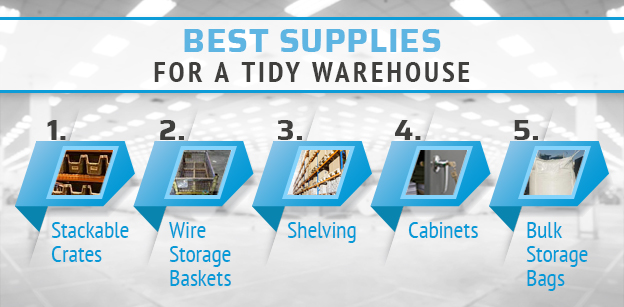
WAREHOUSE ORGANIZATION TIPS
Once you have some great storage supplies at your disposal, you can start organizing the space in a way that works for your business. Every warehouse layout depends on the workflow and use of the space, so it’s not a one-size-fits-all situation. Make sure you have a full sense of the needs of your facility and your employees before you start arranging your storage supplies throughout the space. Talk to your staff members about their needs to better understand how the space should be organized.
With all that in mind, here are some basic organizational tips that will work for almost any warehouse facility:
Invest in Durable and Distinct Labels
No one will be able to find anything in your warehouse unless you invest in some basic signage. Your employees will look at all your shelves and racks like a giant maze, so put up signs to help them make sense of their surroundings. This separates the vast space into a series of manageable categories. You can create categories around different types of products, those going out for shipment, products that need to be inspected, products that have already made it past inspection or whatever makes sense for your process.
Then, it’s time to zero in on individual shelves and products. Every product should have its own place on the shelf. You should then mark the area with the name of the product and SKU number as well as some additional information like color, size or date. Use durable, lasting labels to make sure your product tags don’t get lost in the shuffle.
Keep Popular Products to the Front
Now it’s time to learn the ABCs of warehouse organization. This method means separating your products based on popularity.
The As are the products you and your staff members use the most, usually best-sellers that frequently need to go out for shipment. These products should be up front and easily-accessible, which saves you and staff members precious time, especially if you’re reaching for the same products day in and day out.
The Bs are less popular products but those that are still in demand. You might need your B products less often, but they still need to be within easy reach. The Bs should be behind the As.
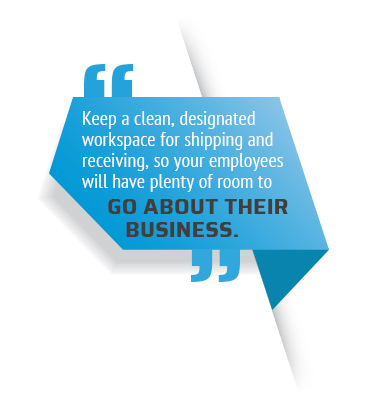
Create a Designated Receiving Space
While most of your warehouse space will go to storage, you’ll need plenty of space to get your products ready for shipment and to receive incoming supplies. Keep a clean, designated workspace for shipping and receiving, so your employees will have plenty of room to breathe and go about their business. No one wants to be bumping into shelves and boxes as they try to unload a new shipment. Have your staff members attend to this space frequently to make sure it’s clear and easy to use.
BENEFITS OF WAREHOUSE ORGANIZATION
If you’re still not sold on the idea of warehouse organization, here are a few more incentives to whet your appetite for organizational glory.
Better Use of Space
You’re paying for this warehouse, so you might as well put it to good use. Your employees can’t do their job if they can’t move around the space freely. It will be difficult to access your products and equipment with dollies and forklifts if there isn’t a discernible path. Keeping your most popular products up front also cuts down on the time it takes to retrieve products, so your employees won’t waste time walking from one end of the facility to the other.
Optimal Employee Efficiency
Labor costs tend to represent around 65 percent of a facility’s overall budget, so you need to make sure your employees are using their time efficiently. If your staff members know where to find the things they need, they can complete certain tasks much more quickly, saving your company a fortune in the long run. Plus, you won’t have to wait around as long for your shipments to get out the door, helping you stay competitive in an increasingly crowded industry.
Fewer Workplace Errors
Nothing ruins your company’s reputation like sending the wrong package or product to one of your customers. If products are mislabeled or in the wrong container, it could lead to some nasty workplace errors down the line. You’ll have to spend a lot of money rectifying the situation if one of your customers ends up with the wrong product by mistake.
TAKE THE FIRST STEPS TO ORGANIZING YOUR WAREHOUSE
Keeping your warehouse organized doesn’t have to be a tall order. If you invest in the right supplies and create a workspace that makes logistical sense, you and your employees can go about your business without wasting precious time or money. Your employees will be less stressed and more focused on the task at hand, so you can make the right impression on your customers.

